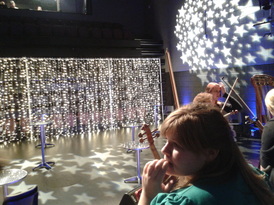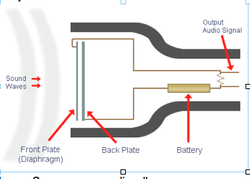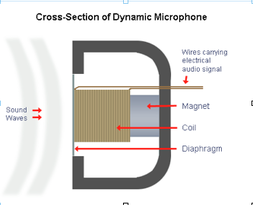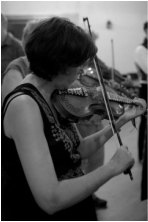 On stage yesterday at Stevenson College's Farewell Our Folkband performed yesterday at Stevenson College's farewell event before it merges with Edinburgh College. It went very well. Stage was a bit small. Here's photo of us at rehearsal. We played John Sommerville's great tune McKechnie's Farewell. Its a slow reel Sounded great. There was also a pop band that was brilliant.
0 Comments
Solo Performance
It was my turn to perform solo today. I played two very old Shetland tunes, Da West Side Bride's March and Da Muckle reel o' Finigart. I have been playing these for about five or six weeks and learned them recently when at Folkworks in Durham. They felt pretty secure before the performance. But what is about performance that makes it difficult to play as well as you normally can? Anyway, it went relatively well given they are new tunes to my repertoire. I also felt it was helpful to take the opportunity to play something new even if not completely perfect so as to get some feedback on these tunes. My final recital of these will be in January. From my perspective, there is little point in playing something from last year's sets. I found it quite difficult to control nerves. That's very annoying. I have been in many scary situations in my life and I feel I should be better at this. I think it is much easier to deliver to an anonymous audience that you probably won't see again than it is to people who you know. As I was asked to play parts again I found these wore off a bit and so that was a helpful exercise in relaxing a bit. Feedback was interesting. I knew that these tunes would be quite esoteric. I think they were to me the first time I heard them. The second one in particular is not a typical reel but has seven parts and has lots of cross beats. It probably didn't help that I didn't manage to perform them perfectly today. I got some helpful feedback on trying to make the audience understand them by being particularly regular with beat and getting the upbeat right as well as trying to emphasise the long notes. I should also try to get the ornaments clearer and not let these get in the way of the tune. These are the same points that my teacher raised. I had managed to improve them a bit but they need more work yet. There was a point about changing from one tune to the next ( which happens in traditional music) and how to make this more obvious to the audience. Better to put a whole bar between the two tunes rather than run straight into the second one. I use the first bar of the second tune to speed up and I should try to do this more evenly. They need more work on dynamics. I am glad I played them. They are interesting and unusual and deserve to be played. You couldn't really play these in the pub or at a ceilidh so a recital is a good place for them. Happy to have done this today. Many thanks to Laurie and Neil. Looking forward to moving onto the next set - Strathspey and reel in G minor. Folk Band Apart from solo work, we have been working up John Sommerville's lovely tune McKechnie's Farewell for a performance tomorrow. Looking forward to that. The arrangement and harmonies are great. We are also working on a few other great tunes which I blogged about earlier and these are coming on too. Folk Band is the highlight of the week for me. Strings Group We also had a strings group rehearsal yesterday and played Telemann's Europa. Its really difficult to get timing as the tempo trebles (?) in the middle of it. Playing parts can be difficult as its sometimes difficult to understand how it all fits together - particularly if you can't see the other parts scores. They are lovely pieces though and we are not that far off performing them. Practising with a metronome required. Tried to use Protools this week but getting some error message about authorisation on the College computers (we tried two).
Last week's performances had some interesting learning points. We talked about how to deal with feeling nervous when playing and coping with P by thinking of it as normal. Less likely to get squeaks that way.
There were also some ideas about how to make the audience understand difficult harmony by emphasising it ( no it wasn't a wrong note - it was meant). Really enjoying my fiddle lessons - challenging but they are making a big difference to my playing. I'm getting ready to perform myself this Thursday. I will be playing some old Shetland tunes. Had a rehearsal today to try out accompaniments. I have been playing the tunes for about five or six weeks so they are quite new to me. But they are coming along. Starting to think about Improvisation today. We did some rhythms and playing Bb blues. I have been practising Tenor Madness but we didn't play it today. We will probably be doing it next week as well as building up rhythms some more.
In the meantime I will be transcribing the solo. Recording Guitars We recorded an electric guitar using Protools yesterday. Its interesting that while there are a few principles there are really no rules and its worth trying different mics and positions to see what you like. Which microphone sounds best might also depend on the room. Try to make sure you have a good guitar, amp and guitarist!. The position of the microphone should be quite close to the amp to record with greatest accuracy and to minimize any sound from the room. The mic should be pointed at a 90 degree angle to the grill. It could be placed dead centre to the speaker or it could be moved towards the outer rim. Apparently this increases the bass and gives a warmer sound than pointing directly to the centre of the speaker. We used two mics yesterday. A dynamic mic in the centre of the amp speaker, pretty much against the speaker cloth. We then added a condenser mic about two feet from the amp (with the - 10 dcb button on so as not to pick up extraneous sounds from the room). We recorded onto two tracks through Protools and it sounded good. Next task is to research how to record other guitars. So what would be the best way to record an bass or an acoustic guitar? Recording Bass Guitar Like any other guitar its good to have a good guitar, well set up and good amp. You might be able to record directly into a mixing desk. From the reading I have done you might be able to record direct (DI) either through an interface or into a DI Box. But many engineers prefer recording with a microphone or a mixture of both. Dynamic or condenser mics? A good choice might be a large diaphragm but Dynamic miss will give good results too. Whatever the choice, the mic needs to be good at responding to low end bass. The rules are similar to recording electric guitar. Place the mic at the centre of the speaker for a bright sound and at the edge for a more mellow sound. Compression might be necessary - although one advantage of recording from speakers is that same compression will have been dealt with naturally as part of the amplification. Recording Acoustic Guitars There are lots of YouTube videos on various layouts of mics that you can try. An interesting article at http://www.humbuckermusic.com/acguitrectec.html gives three techniques for stereo miking. Helpfully it recognises that if you ask five different engineers you will get five different answers but concludes that stereo miking is really the best method. So how do you do it? First, the Spaced Pair. Here there are two mics placed with one pointing to around the 12th fret and one to the bridge. The second technique is a variation of the spaced pair but this time with a mic pointed at the 12th fret of the guitar and the second mic by the players ear above the bridge. You can play around with the positions a bit which can make quite a difference. Apparently this gives a slightly thinner sound than the previous set up. With both of these you should also remember the 3 in 1 rule (getting technical here) which apparently means that you should keep the mics apart three times the distance that you place them from the guitar.
We are learning about recording this year which is fascinating and challenging. Our first lessons involved the basics like looking at the mixing desk, microphones, and learning about safety in the studio. Next we researched different types of microphones. Condenser and Dynamic microphones  Source: www.mediacollege.com There two main types of microphones. Each has pros and cons and they are suited to particular types of recording. Condenser microphones These have a greater frequency response and usually have a louder output. But they also pick up loud noises and are mostly used in studios. They are more fragile than dynamic microphones. They are also more expensive in the main (although you can buy cheap ones). Condenser microphones use a capacitor to convert acoustic energy into electrical signals and they need a power supply too, through a mixing desk or audio interface. There are two main types - large and small diaphragm microphones. Large diaphragm ones are supposed give a warmer sound for bass instruments. Small diaphragm microphones are supposed to be better at picking up fast sounds (eg string instruments). They are sometimes used for live orchestral work.  Dynamic microphones These stand up to wear and tear better, are more reliable. They are also moisture resistant so they are the better choice for live performances. They don’t need their own power like condenser microphones. They withstand high sound pressure and so are better for loud guitars and some drums e.g kick drums, tom toms etc. They pick up lower frequencies well. A good choice of dynamic microphone if you are on a budget is the Schure SM57 for instruments and SM58 for vocals. All microphones have frequency response patterns which means how accurately they can pick up sounds at different frequencies. Ideally a microphone should pick up all frequencies equally well. But the reality is that no microphone can do that and the trick is to pick the right one for the job. So if recording bass drums you shouldn’t use a microphone that is great at picking up treble sounds.
More performances on Thursday. We had an interesting talk about trills. Most people attempt them too fast apparently. Its a good idea to start slower and speed up and we were given some practice tips about how to get the speed up. Finally, trills usually start from the top. I know that about classical music - but I don't think that holds true for folk music. There aren't many trills as such but they do feature in some folk tunes and the way I have often heard them is as a decoration to a long note. So you start on the note and then you might trill up from there. For example, you might trill from an open string to a flat first note or a first to a second. Hmmm. I wonder.
I will be performing on 27th. There is a lot to practice just now, Telemann, Folk Band tunes, performance and improvisation. Still fine tuning sets to play. I had been considering a G major tune followed by a G minor but tried running them and didn't like the change. Its the wrong way so I think I'll stick with all G minor in one set. I have found a great G minor reel which has a bit in third position which I think I'll try. I have been comparing the Shetland tunes I am playing with the transcription of Peter Fraser's playing and they are definitely a bit different. I then checked the recordings of Catriona MacDonald's versions (which I learned) and I am definitely playing in line with them so I'll stick to that rather than change and put it down to variations. Adding double stopping but this is still a work in progress, as is ornamentation. Changed my strings today - don't like them though and have ordered Aricores again which seems to quite suit my fiddle. Bought a Coda bow. Feels quite fast compared to my old one - must be the balance. Not quite as good as pernambuco but cheaper and the upper end ones seem to play well. It'll do me for a while and is good for playing outside. Glad to have my instrumental tuition sorted out.
I am gradually buying the old great Scottish collections. I have been trawling through the tune books and I think I've found a good programme and have now discussed this with my teacher. I am going to play all Scottish tunes this year as I will do my Grade 8 LCM Scottish traditional music exam. There is a rule that all tunes must be Scottish and you must play a number of performance pieces as well as have an additional number of sets as repertoire (which are chosen at random by the examiner). They all need to be learned by heart. (I did my Grade 6 last year). I plan to play one or two of Scott Skinner's tunes. Quite lot of these come across as quite formal or almost as exercises. He was a gifted player with good technique. But I think he must have had a big sense of humour too. He could not write or play some of his tunes otherwise. I'll be trying tunes in the high positions and flat keys. Borrowed Flowers of Scottish Melody , Henderson from the library (much of The Caledonian Companion is taken from sets in this book) . Its difficult to get. I'd love to play blues and country too but maybe next year. |
Fiona Harrison
|


 RSS Feed
RSS Feed
